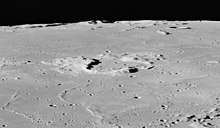Wolf (crater)
Wolf is a lunar impact crater that lies in the south-central part of the Mare Nubium, a lunar mare in the southern hemisphere of the Moon. It lies to the north-northwest of the walled plain Pitatus, and east-southeast of the prominent crater Bullialdus. It is named after the German astronomer Max Wolf.[1]
.png) | |
| Coordinates | 22.7°S 16.6°W |
|---|---|
| Diameter | 25.74 km |
| Colongitude | 17° at sunrise |
| Eponym | M. F. Wolf |
The interior floor of this crater has been completely flooded by lava, leaving only an irregular, broken rim projecting slightly above the surface. The surviving rim is not quite circular, having outward bulges to the north and west. It rises to a maximum height of about 0.7 km. The smaller crater Wolf B has overlaid the southern rim, and the two have now merged into one formation. Low ridges connect to the exterior rim to the east and south.
Satellite craters

By convention these features are identified on lunar maps by placing the letter on the side of the crater midpoint that is closest to Wolf.
| Wolf | Latitude | Longitude | Diameter | Ref |
|---|---|---|---|---|
| A | 22.2° S | 18.4° W | 5.59 km | WGPSN |
| B | 23.1° S | 16.4° W | 15.11 km | WGPSN |
| C | 24.1° S | 14.5° W | 2.65 km | WGPSN |
| E | 23.9° S | 16.3° W | 2.31 km | WGPSN |
| F | 22.0° S | 14.9° W | 2.34 km | WGPSN |
| G | 22.5° S | 16.8° W | 5.7 km | WGPSN |
| H | 23.0° S | 14.7° W | 7.75 km | WGPSN |
| S | 21.2° S | 16.5° W | 29.84 km | WGPSN |
| T | 23.4° S | 18.8° W | 27.1 km | WGPSN |
See also
- 827 Wolfiana
- 1217 Maximiliana
- Mons Wolff (Montes Apenninus)
References
- "Wolf (crater)". Gazetteer of Planetary Nomenclature. USGS Astrogeology Research Program.
- Andersson, L. E.; Whitaker, E. A. (1982). NASA Catalogue of Lunar Nomenclature. NASA RP-1097.CS1 maint: ref=harv (link)
- Bussey, B.; Spudis, P. (2004). The Clementine Atlas of the Moon. New York: Cambridge University Press. ISBN 978-0-521-81528-4.CS1 maint: ref=harv (link)
- Cocks, Elijah E.; Cocks, Josiah C. (1995). Who's Who on the Moon: A Biographical Dictionary of Lunar Nomenclature. Tudor Publishers. ISBN 978-0-936389-27-1.CS1 maint: ref=harv (link)
- McDowell, Jonathan (July 15, 2007). "Lunar Nomenclature". Jonathan's Space Report. Retrieved 2007-10-24.CS1 maint: ref=harv (link)
- Menzel, D. H.; Minnaert, M.; Levin, B.; Dollfus, A.; Bell, B. (1971). "Report on Lunar Nomenclature by the Working Group of Commission 17 of the IAU". Space Science Reviews. 12 (2): 136–186. Bibcode:1971SSRv...12..136M. doi:10.1007/BF00171763.CS1 maint: ref=harv (link)
- Moore, Patrick (2001). On the Moon. Sterling Publishing Co. ISBN 978-0-304-35469-6.CS1 maint: ref=harv (link)
- Price, Fred W. (1988). The Moon Observer's Handbook. Cambridge University Press. ISBN 978-0-521-33500-3.CS1 maint: ref=harv (link)
- Rükl, Antonín (1990). Atlas of the Moon. Kalmbach Books. ISBN 978-0-913135-17-4.CS1 maint: ref=harv (link)
- Webb, Rev. T. W. (1962). Celestial Objects for Common Telescopes (6th revised ed.). Dover. ISBN 978-0-486-20917-3.CS1 maint: ref=harv (link)
- Whitaker, Ewen A. (1999). Mapping and Naming the Moon. Cambridge University Press. ISBN 978-0-521-62248-6.CS1 maint: ref=harv (link)
- Wlasuk, Peter T. (2000). Observing the Moon. Springer. ISBN 978-1-85233-193-1.CS1 maint: ref=harv (link)